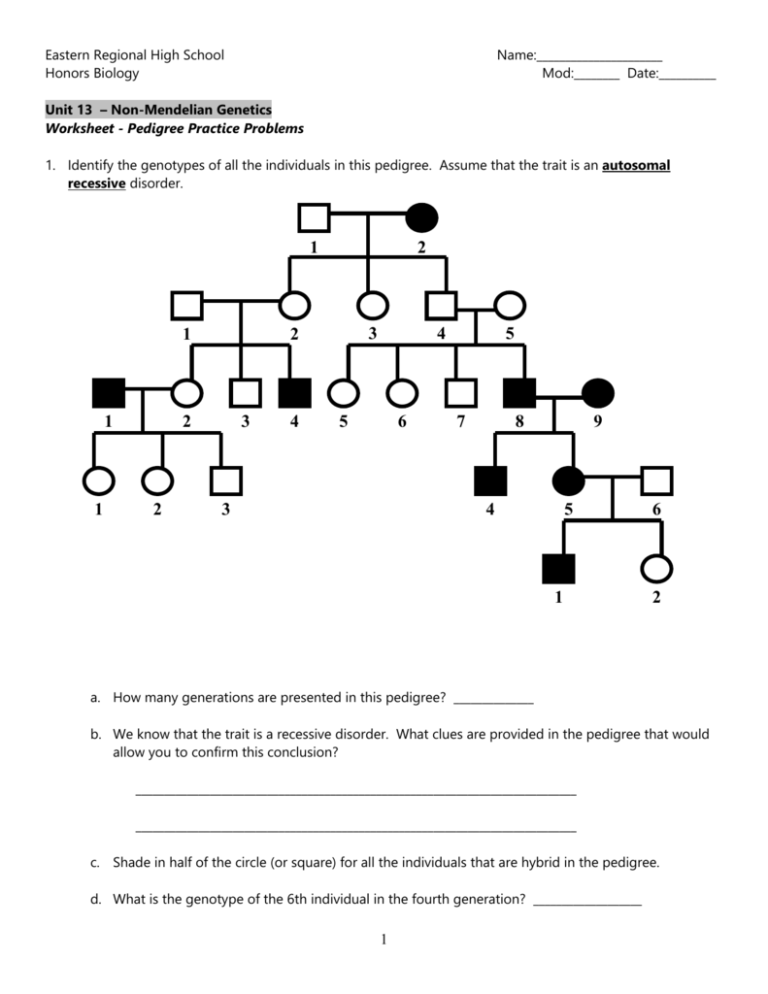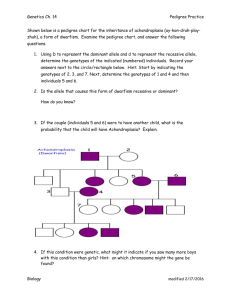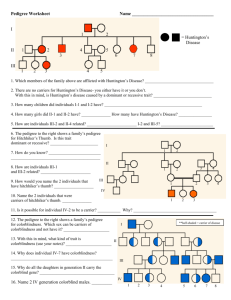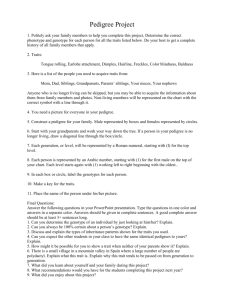Pedigree Practice Problems: Non-Mendelian Genetics Worksheet
advertisement

Eastern Regional High School Honors Biology Name:______________________ Mod:________ Date:__________ Unit 13 – Non-Mendelian Genetics Worksheet - Pedigree Practice Problems 1. Identify the genotypes of all the individuals in this pedigree. Assume that the trait is an autosomal recessive disorder. 1 1 1 1 3 2 2 2 2 3 4 4 5 6 3 5 7 8 9 4 5 1 6 2 a. How many generations are presented in this pedigree? ______________ b. We know that the trait is a recessive disorder. What clues are provided in the pedigree that would allow you to confirm this conclusion? _____________________________________________________________________________ _____________________________________________________________________________ c. Shade in half of the circle (or square) for all the individuals that are hybrid in the pedigree. d. What is the genotype of the 6th individual in the fourth generation? ___________________ 1 e. Explain why some individuals can have multiple genotypes. Provide an example. _____________________________________________________________________________ _____________________________________________________________________________ _____________________________________________________________________________ 2 2. Examine the pedigree below for an autosomal recessive disorder. Determine the genotypes of all the individuals in the pedigree. 1 1 1 2 2 3 2 3 3 4 4 5 4 5 6 7 6 a. What is the genotype of individual 2 in the first generation in the pedigree? Explain your answer. _____________________________________________________________________ _____________________________________________________________________ b. What are the genotypes and phenotypes of individuals 3 and 4 in the second generation? _____________________________________________________________________ c. Shade in the left half of the circle (or square) for all the individuals that are hybrid in the pedigree. d. If the 4th individual in the 3rd generation married a female that was hybrid for the disease above, what percentage of their offspring would exhibit the disease? _____________________________________________________________________ 3 3. Examine the pedigree below for an autosomal dominant disorder. Determine the genotypes of all the individuals in the pedigree. 1 1 1 1 2 2 2 3 4 3 2 5 4 3 6 5 7 6 4 a. What is the genotype of individual 1 in the first generation in the pedigree? Explain your answer. _____________________________________________________________________ _____________________________________________________________________ b. What are the genotypes and phenotypes of individuals 4 and 5 in the second generation? _____________________________________________________________________ c. If the 3rd individual in the 4th generation married a female that was homozygous recessive for the disease above, what percentage of their offspring would exhibit the disease? _____________________________________________________________________ d. We know that the trait is a dominant disorder. What clues are provided in the pedigree that would allow you to confirm this conclusion? 4 _____________________________________________________________________ _____________________________________________________________________ e. Why are there no half-shaded individuals in this pedigree? _____________________________________________________________________ 5 4. This pedigree shows the inhertiance of Huntington’s disease. There are no carriers for Huntington’s Disease- you either have it or you don’t. With this in mind, is Huntington’s disease caused by a dominant or recessive allele? ___________________ I II 1 2 1 2 4 5 3 6 7 8 III 1 2 3 4 5 a) Which members of the family above are afflicted with Huntington’s Disease? ____________________________ b) How many children did individuals I-1 and I-2 have? _______________________________________________ c) How many girls did II-1 and II-2 have? ___________ How many have Huntington’s Disease? _______________ d) How is individual III-2 and II-4 related? _____________________ I-2 and III-5? _______________________ 5. The pedigree to the right shows the passing on of Hitchhiker’s Thumb in a family. Is this trait dominant or recessive? ____________________ How do you know? ______________________ I a) How are individuals III-1 and III-2 related? ________________________ b) Name 2 individuals that have hitchhiker’s thumb. __________________ c) Name 2 individuals that are carriers of hitchhiker’s thumb. ______________ 1 2 1 2 II II I 3 1 2 IV 1 6 4 2 3 3 4 6. The pedigree to the right shows the passing on of colorblindeness. What sex is the only one that can be carriers of colorblindness? __________________________ I a. Is it possible for individual IV-2 to be a carrier? __________ Why? __________________________________ b. With this in mind, what kind of non-mendelian trait is colorblindness? ______________________ c. Why does individual IV-7 have colorblindness? __________________________________________ d. Why do all the daughters in generation II carry the colorblind gene? _________________________ II II I IV 1 e. Name 2 IV generation colorblind males. _________ 7 2 3 4 5 6 7 Alkaptonuria is an inherited defect characterized by darkening cartilage in the ears, melanin spots in the eyes, proneness to arthritis, and darkening of urine upon exposure to air. It is caused by a metabolic error that results in the failure to produce an enzyme called homogentisic acid oxidase (HGAO). Because normal amounts of the HGAO enzyme are missing, homogentisic acid (HGA) is not used and builds up in the body. Use this pedigree for Alkaptonuria to determine the genetic basis of this trait. Determine the genotypes of all the individuals in the pedigree above. 1 1 1 2 2 3 4 5 6 3 4 1 2 4 3 2 7 5 8 6 9 7 8 4 3 a. Based on the info in the pedigree is this trait autosomal or sex-linked? _________________ b. Is this trait produced by a dominant or recessive allele? _____________________ c. What is the genotype of the 3rd and 4th individuals in the third generation? ___________________ d. What is the genotype and phenotype of 4th individual in the fourth generation? __________________________________________ 8






